| Please access the following URL if you want to secure using SSL. All pages in the site will be secure pages. |
| https://secure02.blue.shared-server.net/www.fish-food.co.jp/message english 7.2019.html |
Welcome to FISH FOOD TIMES
Jul. 2019 issue No.187


Red sea urchin squid sushi
Red sea urchin that has a high praise for its taste
This month's issue will be about the seasoned red sea urchin.
Red sea urchin belongs to Echinacea order, Echinina suborder, Strongylocentrotidae family, Pseudocentrotus genus.
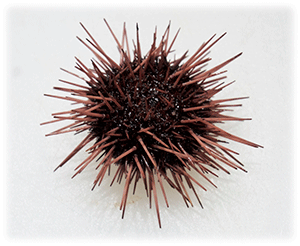
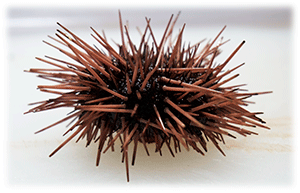
The red sea urchin has a reddish color overall, and the thorn is long as a bahun's sea bream, but its pointed and long thorn is not so hard and can be touched with bare hands. The upper right image, taken from the side, has a slightly flat shape and shows the characteristics of a green sea urchin relative.
There are many red sea urchins near the northwestern part of the Kyushu coast, and it is rare to get out of the Kyushu region because of limited catches, so it was hardly known until now in eastern Japan, which is far from Kyushu. Recently, however, more people are aware of the rich sweetness of red sea urchins, and now the sea urchin is getting higher and higher due to the imbalance between supply and demand, and it is the highest rated and most expensive sea urchin.
The fishing season of the red sea urchin is only about three months in summer, mainly from July to August in the year. Red sea urchins live in deep water so they can hide behind rocks, and if they are damaged during fishing they will lose their thorns and die, so red sea urchin fishing is compared to other sea urchins It is very difficult. For this reason, red sea urchin is a rare species that is often caught by the traditional plain-crested fishing method, and the amount of catch is decreasing year by year, and its rich sweetness is also said to be "the best Japanese sea urchin", and it said "urchin of the illusion" or "the king of sea urchin".
In Hokkaido, short-spined sea urchin is also referred to as akauni, but it is not red in appearance like red sea urchins, but it is commonly called akauni (red) because the gonad in the shell is reddish, On the other hand, the gonads of northern sea urchin are whitish and so are called shirouni (white).
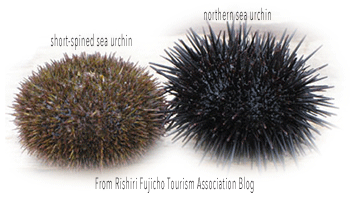
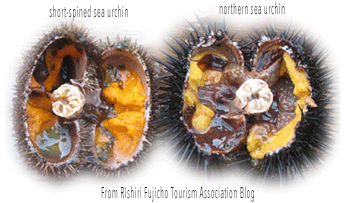
About 140 kinds of sea urchins inhabit Japan, and sea urchins that are edible among them are red sea urchin, short-spined sea urchin, northern sea urchin, green sea urchin, purple sea urchin, striped sea urchin, etc. , 6 types (except black longspine urchin with poison to long spikes). Of these six species, northern sea urchin is the largest catch, accounting for nearly 40% of all sea urchins, and about 60% or more when short-spined sea urchin is added. The other four types including red sea urchins are less than 40% together.
Domestic production and import of sea urchin
In recent years, sea urchin production has changed as follows throughout the country.

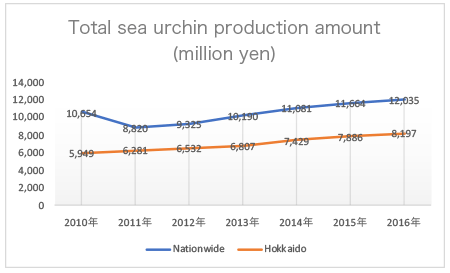
As you can see from this graph, it can be inferred that the price of sea urchin is getting higher year by year. This is because, despite the fact that the sea urchin production in the whole country is almost flat and has not increased much, the amount of money tends to increase.
The use of sea urchins is considered to be mostly used by sushi in a raw state, and demand for sea urchins has increased, supported by the popularity of sushi. However, the production of sea urchins in Japan was short of demand, so many sea urchins have been imported from abroad into Japan.
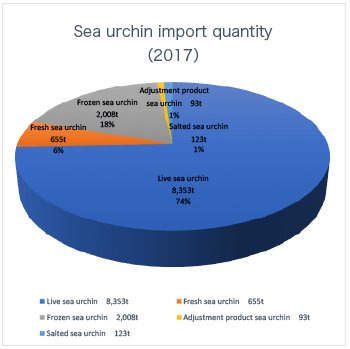
Live shelled sea urchins were imported with 8,353 tons in 2017 and reached 8,492 tons in 2018, but their import volume increased slightly. However, fresh raw sea urchins were 79.6% over the previous year, 565 tons in 17 years to 521 tons in 18 years, and imported frozen sea urchins amounted to 1,772 tons in 17 years from 2,008 tons in 18 years, It was 88.2% compared to the previous year and was significantly lower than the previous year.
Thus, let's consider the factor that imports have started to decrease despite the shortage of sea urchins in Japan. It used to be a time when Japan was almost exclusively importing sea urchin from all countries, but recently Japanese food has boomed around the world, sushi's popularity has grown steadily, and sea urchin has become consumed worldwide as well. The As a result, the fact that prices are being traded at a higher price than before seems to be the reason behind the stagnation of imports.
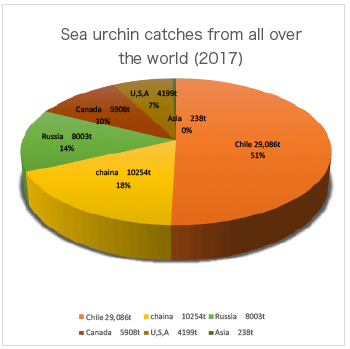
Like other fish, sea urchin also needs rising due to the Japanese food boom and sushi boom in the world and prices are rising, so imported frozen sea urchin, which has been realized as a substitute for domestically produced sea urchin, is the future may not be easy to eat.
Well, in such times, many of the fish sellers have not seen the original form of sea urchin properly, so even if they arrive in the store as a round figure, I think htat they may not know how to handle it. So, in this issue, I wanted to write basic knowledge about sea urchins that by to use the finest red sea urchins .
The working steps for removing the red sea urchin gonads are described below.
| Process is taken out gonads of the red sea urchin | |
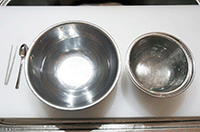 |
|
| 1,From the left, tweezers, small spoons, 3% salt water, colander and bowl are necessary for work. Besides, it is not in the picture, but the cooking scissors. | |
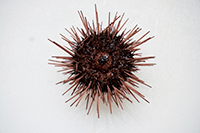 |
 |
| 2,Turn the mouth side up in the lower part of the red sea urchin. The anus is at the top of the back side. | 6,Take care not to damage the gonad from the half-cut shell and take it out with a spoon. |
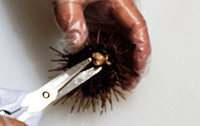 |
 |
| 3,Remove the round and hard part with mouth and teeth by cooking scissors. | 7,lace gonads in a bowl containing 3% salt water and colander. If the concentration of salt water is too low, it is easy to lose its shape, so be careful. |
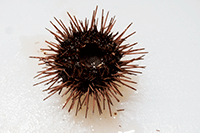 |
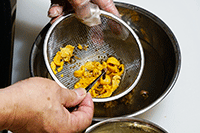 |
4,Condition after removing the round and hard part |
8,Remove the remaining esophagus and intestines tangled on the gonad with tweezers. |
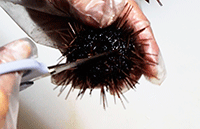 |
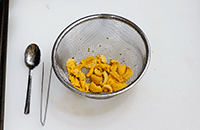 |
| 5,Insert cooking scissors from the hole and cut the shell in half. The gonad is in the form of five stars, and it is cut while confirming its shape. | 9,Remove the inedible impurities and leave the gonad left in the colander. |
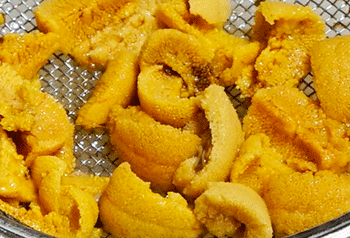 |
|
| 10,A magnified image of the gonad immediately after removal from the red sea urchin. | |
Please take a close look at the enlarged image above. I think that it can be distinguished that there are two types of slightly reddish yellow and whitish yellow. Males and females judge this because male testes are reddish and female ovaries are whitish. Males and females have different tastes, and the reddish male testis is richer and more delicious. It is better to know that the market price is high for products that collect only this reddish testis.
Alum's merits and demerits
By the way, although the gonad just after taking out from inside the shell maintains a beautiful form like the upper image, if it leaves it as it is, since the form will collapse sloppyly immediately, it must be careful.
Alum water, in which alum is dissolved in water at a ratio of 0.25 to 0.7%, compensates for the defect that the shape of the sea urchin's gonad collapses immediately. Alum is a kind of mineral called anhydrous potassium aluminum sulfate, and it plays the role of preservative as well as maintaining the shape of gonad. This is also included in baking powder when making sweets, and if it is only a small amount, there is no problem with the human body, but if it is ingested and accumulated in large amounts it affects the liver and kidneys.
People who dislike sea urchins often mention bitterness as the reason, but it is often this alum that makes the cause. When fishermen from all over the country sell in the form of sea urchin, it is safe to assume that almost 100% of them are basically dipped in alum water and shaped and shipped. Of course, you should think that alum is used for frozen plate sea urchin imported from foreign countries such as Chile, and basically, the sea urchin and alum as products are in an inseparable relationship.
There is a product which put raw sea urchin in the salt water in the inside, and this seems to be selling the thing which does not use alum. Unfortunately, not only do we have to be prepared for the shape of the gonad to be broken down, but it is possible that some umami components may be drained into the salt water.
The image below is a 100g standard red sea urchin in a board box. It is a product that you have to be prepared for the purchase of this sea urchin for several thousand yen, and it is hard work how much time and effort is needed to make a product with such a size and shape Imagine trying, but it is better to think that this is not unrelated to alum.
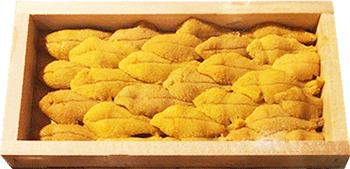
The standard of sea urchin is based on an internal capacity of 100 g as a basis, and larger ones such as 150 g, 180 g, 230 g and smaller ones such as 80 g, 50 g. There are other products such as bottled and salted water, but what is generally familiar is the 100 g standard product of a board box.
If one piece of red sea urchin in a board box is used for assorted sashimi, the cost of goods will jump immediately. So in recent years, I have seen very few special ordering dishes of assorted sashimi using one board box sea urchin like the lower image I created in 2012.
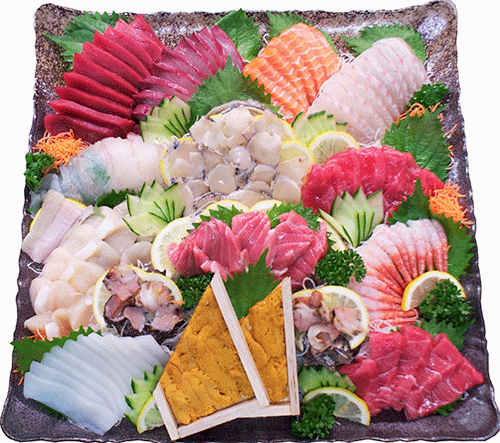
If you use not only red sea urchins but also abalone, bluefin tuna, flounder etc. as materials like this special ordering dishes of assorted sashimi, the selling price will be slightly over 10,000 yen. Therefore, there is also a method like the image below, which uses only half of "half of the board box sea urchin" to reduce the cost even a little.
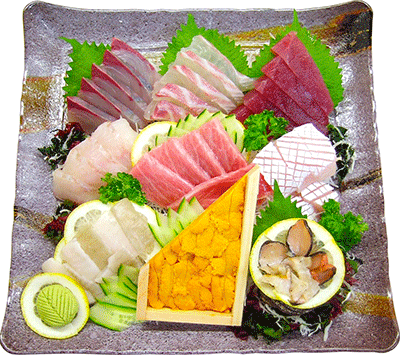
Thus, even if it uses half of the sea urchin, there is no doubt that it is a very expensive and luxurious material for the assorted sashimi. For this reason, it may be possible to use the sea urchin smaller and smaller, but if it is made smaller, the cost of the sea urchin is very high and the appearance is not so good, so generally the sea urchin is subdivided It is rarely used for assorted sashimi.
Red sea urchin and spear squid, combining the two seasons
Although sea urchin basically makes you feel very expensive when trying to sell it alone, it is possible to improve sea urchin's cost performance by combining sea urchin with a slightly cheaper material.
For example, specifically, it is a squid that summer is in season. The name is Yariika in northern Kyushu, but it is shiroika in the San-in region and akaika in Kanto.
Using this spear squid, I tried to make a product combined with the red sea urchin. First of all, after dismantling the fresh spear squid, the well-washed squid fin and geso were prepared, and this was mixed with red sea urchins to commercialize sashimi.
| Red sea urchin mixed with spear squid | |
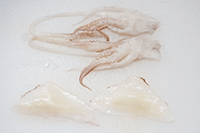 |
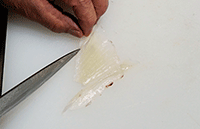 |
| 1,Squid fin and geso after dismantling spear squid. | 4,Remove the squid fin thinly. |
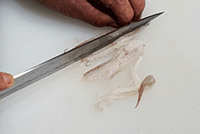 |
 |
| 2,Cut the geso short. | 5,Prepare the red sea urchin. |
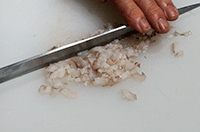 |
 |
| 3,Finely chop Geso. | 6,Geso and squid fin can be mixed with sea urchin in separate bowls. |
 |
|
| Sashimi with red sea urchin in spear squid | |
Since the product in the above image is not a site that is originally used for sashimi and squid fin, if the yield rate is calculated and considered as an unnecessary site, the cost can be regarded as zero yen, so this product is possible to have a cheap selling price and the markup ratio will be quite large.
However, after all, it will be sushi rather than sashimi that sea urchin's turn comes to many. The sea urchin has established itself as a luxury sushi dane for sushi, as the slightly assorted sushi is likely to contain the sea urchin gunkan sushi. There is nothing new about sea urchin gunkan sushi, so I will explain red sea urchin squid sushi that combines red sea urchin and spear squid on the first page image.
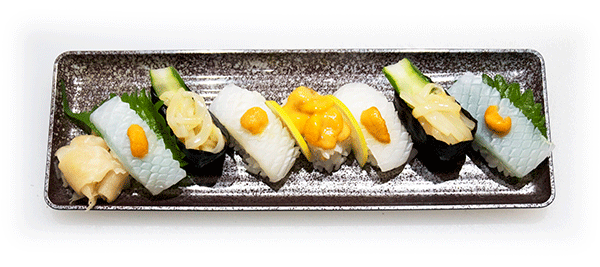
This will be explained in words below because there is no image of the work process.
1,After disassembling and opening the spear squid, take a thin skin of the whole body, and take a large part of the whole body as a rectangle of hitotake width (about 8 cm). Next, put a matkasa-patterned decorative knife on the sakudori surface, hot water frost and chill in cold water. After cooling down, wipe off the water and cut to the width of sushidane.
2,The sushidane with the matsukasa pattern is made by cutting the large leaf in half and sandwiching it with the sushirice to make a sushi, and finally topping one red sea urchin.
3,The triangular part left after cutting tanzaku into a rectangle is cut into a long noodle-like shape, red sea urchin is put in a bowl and mixed, and this is topped on the gunkan sushi.
4,The sea urchin in the middle of the 7 kan sushi in the image above is squared with sushi rice, and then a red sea urchin is topped on it using a spoon.
In this way, the work of the upper image was completed. And the postprandial feeling of those who ate these was the highest rating. After all, "Red sea urchins not soaked in alum water" has a thick sweetness that is still said to be the king of sea urchins, and I thought it would be desirable for people who dislike sea urchins to eat once.
Possibility of stable supply that sea urchin aquaculture may open
Most of the raw sea urchin products currently distributed in the country are not in a shelled state, but are dismantled to provide only gonads of edible parts, so you can eat everything except containers. For this reason, the commodity price of sea urchin including the troublesome processing labor and the like is a high-class product having an average market price of 1,000 yen to 2,500 yen per 100 g, that is 10,000 yen to 25,000 yen per 1 kg. Above all, the highest quality red sea urchin is a substitute that can not be obtained unless you prepare for 100g ¥ 3,000, so it can be said that it is a very special super luxury item.
It is a sea urchin that is traded at such a high price, but on the other hand it has an aspect that it is disliked as an awkward person who cause shore-burning because it is an organism based on seaweed. Although sea urchin basically eats various seaweeds such as eisenia bicyclis, coralline and wakame as well as kelp, it can not actually survive unless it is seaweed, and it is essentially omnivorous and also feeds animal food.
A recent topic is that sea urchin aquaculture experiments are flourishing using cabbage that was previously discarded for non-standard reasons. Also, just recently, on June 18, 2019, Assistant Professor Kurita of Kyushu University Agricultural Research Institute has just announced that it can cultivate purple sea urchin using a clover that anyone can relatively easily grow, Assistant Professor Kurita It is said that sea urchin aquaculture experiments using bamboo shoots from Leave bamboo forest have also started.
If sea urchin gets too much, it will cause shore-burning, so it will be near the end of the sea urchin fishing season and the time of egg laying, and if it is judged that the population is too large to be excessive, it will be exterminated and discarded. However, as mentioned above, if the sea urchins that have been exterminated so far are farmed and production goes on track, the current tight supply will be relaxed a little and prices will settle a little. If so, chances of eating sea urchin may also increase a little.If sea urchin aquaculture can enter a practical and industrially practical phase, I would like to target red sea urchin, which is also the most rare species.
According to a recent academic survey, some of the sea urchins have an endemic species that counts 200 years of age, and some of them are strong at 100 as well as 10 years old. Because sea urchin is a living creature that has only a large gonad in that round body, it's terribly horrible, envy ...?.
| Please access the following URL if you want to secure using SSL. All pages in the site will be secure pages. |
| https://secure02.blue.shared-server.net/www.fish-food.co.jp/message english 7.2019.html |
An opinion and the communication are to iinfo@fish food times
Date of updating 1 Jul. 2019
